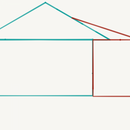Soffit vents, but no ridge vent
Hi all, first post here. My wife and I bought a Craftsman home built in 1924 back in March of this year. Bristol TN, climate zone mixed humid. Turns out a 95 year old home is a handful for a pair of first time home buyers!
We just had a new roof installed and none too soon, it took 14 new sheets of OSB to get the decking back into shape.
The contractor deleted the old roof vents and added ridge vents to both the main ridge and the ridge on the “dormer” style room typical of the Craftsman style. So far so good. It already had soffit vents front and rear.
I was up in one of the attic spaces recently to work on some low voltage wiring and noticed that it doesn’t have any “outflow” venting. It has the soffit vents mentioned, but it’s an addition to the house and when the addition was done they simply built on top of the old roof at a reduced angle to extend the roof line. Where the two meet it’s sealed up. So the old soffit vents, if they exist, are under the old eaves inside the attic and the new roof section has soffit vents but no good way for air up in the cavity created between the old roof and the new to escape.
I’ve attached a quick sketch of the geometry. Red is the addition. Both sides of the house have venting at the eaves but where the red roof meets the green roof there’s no airflow.
I’m wondering is my best bet is to simply get a hole hog rental and pop a bunch of holes from the addition attic up to the original attic? Leave it alone? Spray foam the whole underside of the deck and seal it up, soffit vents included?
Thanks!
Nathan
GBA Detail Library
A collection of one thousand construction details organized by climate and house part










Replies
Nathan,
Leaving it alone is certainly an option if there are no signs the the lack of ventilation is causing problems. But I'd be inclined to drill those holes. They do no harm, and potentially a lot of good.
That was my thinking as well. Before I do anything I'll get up into the other attic and make sure that where I plan to drill actually has a ventilation patb up to the ridge vent.
Connecting the two attics could also help solve part of my low voltage wiring issues as well.
Thanks,
Nathan
I recommend wearing a hard hat while you’re doing this work. Leather gloves too. The two issues these protect against:
1- you raise your head up, the hard hat keeps a roofing nail from “nailing” you in the head.
2- your hole saw snags, spins your drill around, and bashes your hand into an exposed roofing nail.
A good cordless drill and a brand new good quality hole saw are what you probably want to use here. If you have blown insulation in your attic, I also recommend wearing a full Tyvek suit so that you aren’t laying directly in the insulation. You’ll save yourself a LOT of itching with the Tyvek suit.
Bill
I've got all of that, I used a 3M PAPR respirator that has a full face shield and a low grade hardhat built in. Good enough to keep nails out.
I've been up there twice and the second time resulted in a Tetanus booster so I'm not looking to repeat the experience!
Ouch!
Strange vaguely related fact: Poking your head on a nail hurts a lot more once you lose your hair. You wouldn't think it provides much protection, but I know from experience it does.
Another fun fact: the tetanus-causing organism lives in the ground, so you generally don’t have a risk of infection from rusty nails up in the air in places like an attic. Tetanus isn’t caused by rust, it’s caused by a bacterium. This is a good reason to always cleanup any nails dropped on the ground outdoors after a project, and stainless nails are just as much of a risk as bright nails.
In an attic, your big risks are puncturing your skull (which has happened to people), or big scrapes and gashes, which is what always seems to happen to me. If you’ve had rodents up there, then you have risk of infection again from things those little critters carry.
Bill